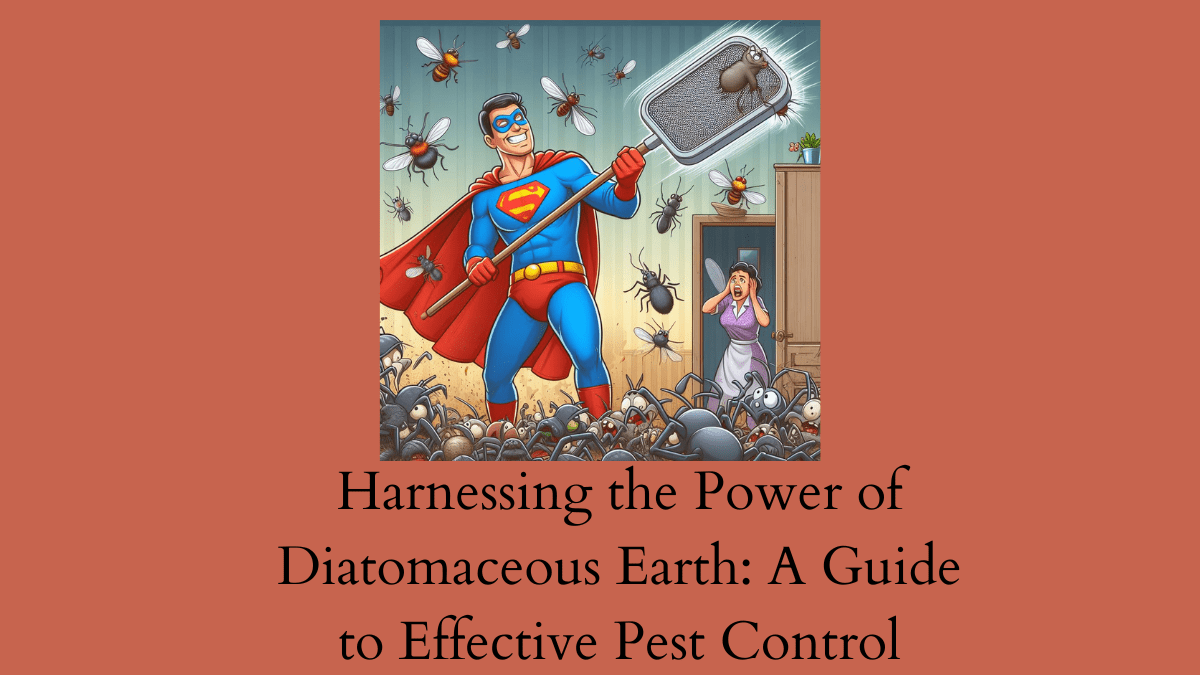Introduction:

To maintain a healthy and pest-free environment, many individuals are turning to natural and eco-friendly alternatives for pest control. One such solution gaining popularity is diatomaceous earth (DE). This versatile substance is not only effective but also safe for humans, pets, and the environment. In this article, we’ll explore what diatomaceous earth is, how it works, and provide a comprehensive guide on using it for pest control.
Understanding Diatomaceous Earth:
Diatomaceous earth is a naturally occurring sedimentary rock composed of fossilized diatoms, a type of hard-shelled algae. It comes in the form of a fine powder and is rich in silica, making it an abrasive and absorbent substance. While it’s harmless to humans and pets, its microscopic sharp edges make it lethal for various pests.
How Diatomaceous Earth Works:
Mechanical Action:
Diatomaceous earth works by physically damaging the exoskeletons of insects, causing them to dehydrate and die.
Its fine particles have microscopic, sharp edges that cut through the protective waxy layer of insects, leading to the loss of moisture.
Absorption:
DE has a high absorbent capacity, effectively soaking up the lipids from the outer layer of insects, further contributing to their dehydration.
Using Diatomaceous Earth for Pest Control:
Selecting the Right Type:
Food-grade diatomaceous earth is the safest option for pest control, ensuring it’s free from harmful additives.
Identifying Target Pests:
DE is effective against a variety of pests, including ants, fleas, bed bugs, cockroaches, and even garden pests like slugs and snails.
Application Techniques:
Indoor Use:
Sprinkle a thin layer of DE in areas where pests are present, such as along baseboards, behind appliances, and near entry points.
Use a duster to apply DE to hard-to-reach areas like wall voids and electrical outlets.
Outdoor Use:
Apply DE in the garden to control pests by dusting plants, soil, and around the perimeter of your home.
Reapply after rain or heavy watering, as DE is most effective when dry.
Pet Protection:
Dust pets with food-grade DE to control fleas and ticks. Ensure thorough coverage, and avoid the eyes and nose.
Add a small amount of DE to pet bedding to prevent infestations.
Safety Measures:
Wear a mask to avoid inhaling DE during application.
While safe for humans and pets, it’s best to apply DE in areas where direct skin contact is minimal.
Conclusion:
Diatomaceous earth stands as a formidable ally in the battle against pests, offering an eco-friendly and non-toxic solution. By understanding its mechanism and following proper application techniques, you can harness the power of DE to create a pest-free environment in your home and garden. Embrace this natural alternative, and let diatomaceous earth pave the way for a healthier, happier living space. Harnessing the Power of Diatomaceous Earth: A Guide to Effective Pest Control
Introduction:
In the pursuit of maintaining a healthy and pest-free environment, many individuals are turning to natural and eco-friendly alternatives for pest control. One such solution gaining popularity is diatomaceous earth (DE). This versatile substance is not only effective but also safe for humans, pets, and the environment. In this article, we’ll explore what diatomaceous earth is, how it works, and provide a comprehensive guide on using it for pest control.
Understanding Diatomaceous Earth:
Diatomaceous earth is a naturally occurring sedimentary rock composed of fossilized diatoms, a type of hard-shelled algae. It comes in the form of a fine powder and is rich in silica, making it an abrasive and absorbent substance. While it’s harmless to humans and pets, its microscopic sharp edges make it lethal for various pests.
How Diatomaceous Earth Works:
- Mechanical Action:
- Diatomaceous earth works by physically damaging the exoskeletons of insects, causing them to dehydrate and die.
- Its fine particles have microscopic, sharp edges that cut through the protective waxy layer of insects, leading to the loss of moisture.
- Absorption:
- DE has a high absorbent capacity, effectively soaking up the lipids from the outer layer of insects, further contributing to their dehydration.
Using Diatomaceous Earth for Pest Control:
- Selecting the Right Type:
- Food-grade diatomaceous earth is the safest option for pest control, ensuring it’s free from harmful additives.
- Identifying Target Pests:
- DE is effective against a variety of pests, including ants, fleas, bed bugs, cockroaches, and even garden pests like slugs and snails.
- Application Techniques:
- Indoor Use:
- Sprinkle a thin layer of DE in areas where pests are present, such as along baseboards, behind appliances, and near entry points.
- Use a duster to apply DE to hard-to-reach areas like wall voids and electrical outlets.
- Outdoor Use:
- Apply DE in the garden to control pests by dusting plants, soil, and around the perimeter of your home.
- Reapply after rain or heavy watering, as DE is most effective when dry.
- Pet Protection:
- Dust pets with food-grade DE to control fleas and ticks. Ensure thorough coverage, and avoid the eyes and nose.
- Add a small amount of DE to pet bedding to prevent infestations.
- Safety Measures:
- Wear a mask to avoid inhaling DE during application.
- While safe for humans and pets, it’s best to apply DE in areas where direct skin contact is minimal.
Conclusion:
Diatomaceous earth stands as a formidable ally in the battle against pests, offering an eco-friendly and non-toxic solution. By understanding its mechanism and following proper application techniques, you can harness the power of DE to create a pest-free environment in your home and garden. Embrace this natural alternative, and let diatomaceous earth pave the way for a healthier, happier living space.
